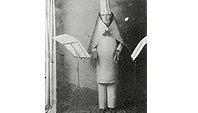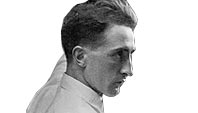Zurich

Ringleader:
Hugo Ball
Typical Scene:
Cacophonous performances at the Cabaret Voltaire, as described by Hans Arp: “Our replies” to laughter are “volleys of hiccups, moos and the miaowing of medieval Bruitists.”
Media Stunt:
Fake press release announcing a duel between Dada Manifesto author Tristan Tzara and Arp.
Slogan
“Dada m’dada dada mhm, dada dera dada, dada Hue, dada Tza.”
Act of Protest:
Evenings of antiwar performances featuring tribal chants and readings of obituaries.
Signature Work:
Arp’s collages of torn paper arranged by chance.
Female Artist-Muse:
Model, nightclub hostess, and lady-of-the-night Emmy Hennings.
Berlin
Ringleader:
Richard Huelsenbeck
Typical Scene:
The First Dada Evening of 1918, at the Berlin Sezession: readings of manifestos, jazz dancing, and the bouncing of soccer balls off spectators’ heads.
Media Stunt:
The satirical broadsheet Everyone Has His Own Soccerball holds a mock beauty contest between leading politicians.
Slogan:
“What is Dadaism and what does it want in Germany?”
Act of Protest:
“Care packages” were sent to German soldiers by George Grosz, including items like dog food, shirt protectors, and teabags customized with patriotic slogans.
Signature Work:
Photo-montages by John Heartfield and Raoul Hausmann.
Female Artist-Muse:
Hannah Höch, photo-montage artist and sometime lover of Hausmann’s.
Paris
Ringleader:
André Breton
Typical Scene:
Friday poetry readings hosted by the magazine Littérature (example: Tzara reads from the newspaper while other Dadaists drown him out with clanging bells).
Media Stunt:
Dadaists distribute false information to newspaper offices stating that Charlie Chaplin will be performing with them.
Slogan:
“Dada is the world’s biggest hoax.”
Act of Protest:
At the 1920 Festival Dada, the audience pelted performers with eggs, meat, vegetables, and coins; a brawl ensued.
Signature Work:
Man Ray’s sculptural object Cadeau, a flatiron with spikes on the plate.
Female Artist-Muse:
Artist Suzanne Duchamp (Marcel’s sister).
New York

Ringleader:
Marcel Duchamp
Typical Scene:
Louise and Walter Arensberg’s apartment at 33 West 67th Street—described by Francis Picabia’s first wife as “an inconceivable orgy of sexuality, jazz, and alcohol.”
Media Stunt:
Rrose Sélavy, Duchamp’s seductive female alter ego.
Slogan:
“Dada places doubt above everything.”
Act of Protest:
In 1917, Duchamp climbed to the top of the Washington Square arch with balloons, and declared Greenwich Village “a free republic, independent of uptown.”
Signature Work:
Duchamp’s Fountain, his urinal-as-readymade sculpture, rejected by the 1917 Society of Independents exhibition.
Female Artist-Muse:
The German war widow Baroness Elsa von Freytag-Loringhoven, known for wandering the streets dressed in a French military headdress and tin-can brassiere.
Dada
The Museum of Modern Art. June 18 through September 11.